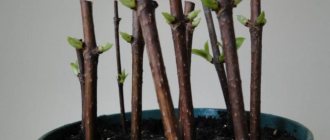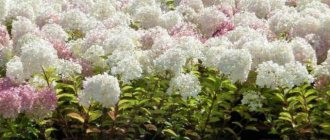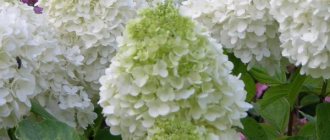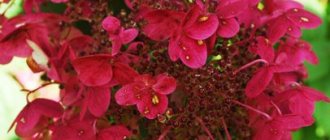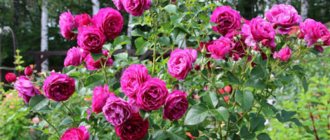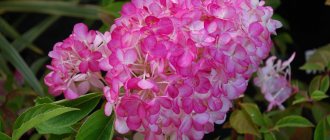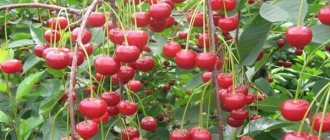Description of hydrangea Grandiflora
Hydrangea Grandiflora is a shrub up to 2 m high with decorative properties. The root system is located near the surface of the earth. The crown is spherical, reaches 3 m in girth. The leaves are elongated, up to 10 cm long.
The shrub produces pyramidal panicles up to 20 cm long. The inflorescences consist of flat white flowers with a diameter of 3 cm. After flowering, no fruits are formed. Over the course of the season, the flowers change color from cream to white, then turn pink. At the end of flowering, the panicles become greenish-burgundy in color.
Important! Hydrangea Grandiflora blooms from early June to September.
Hydrangea has been growing in one place for more than 30 years. The shrub grows quickly, the length of the shoots increases by 25 cm per year. Flowering begins 4-5 years after planting in the ground. Small inflorescences appear in the second or third year. Grandiflora tolerates winter frosts well and is resistant to diseases and pests.
The shrub is suitable for decorating garden plots, parks and recreation areas. The Grandiflora variety is planted on lawns, in the center of flower arrangements, next to other ornamental shrubs.
History of variety selection
Grandiflora is an ancient variety of paniculate hydrangea, bred in 19860. The plant's homeland is considered to be East Asia, or more precisely Japan. According to legend, on Buddha's birthday, white hydrangea petals fell from the sky. Tea made from the leaves of this flower is considered mystical and is used in rituals. In the east, paniculata Grandiflora is called “longing for water.” There are more than 80 species of hydrangeas in the world. There are about 12 varieties in garden plots, parks and botanical gardens.
Features of the variety
According to the description, Hydrangea paniculata Grandiflora is a deciduous shrub that grows up to 2 m in height. It can reach 3 m in diameter. The inflorescences include small flowers. They have a pyramidal shape. The length of the inflorescences can be 30 cm. The flowers are usually sterile and do not form fruits.
At first the inflorescences have a creamy tint, and then become white and even pinkish. By autumn, hydrangea takes on a green-red hue. Flowering lasts from June to September. The leaves have an elongated shape and reach a length of 12 cm. They are covered with fluff below.
Note! Full flowering begins 4-5 years after planting. However, the first rudiments of buds can form as early as 2-3 years.
Hydrangea has white flowers
Photo of hydrangea Grandiflora
How to use in the garden
Giving “Grandiflora” a standard form allows you to use this hydrangea as a park or potted plant, decorating grand staircases and driveways, balconies, verandas and patios. When creating landscape landscapes on a site, gardeners recommend leaving the bushy form, planting it as a single plant or in a group. When planting in groups, it is better to place “Grandiflora” in the foreground, using mock orange and rowan as a background. It looks luxurious when planted as a hedge, creating a beautifully blooming dense barrier.
Attention! “Grandiflora” should not be planted next to fruit plants, otherwise competition for water will arise between them.
Hydrangea should not be grown next to fruit trees.
Blooming hydrangea can be used for cutting, and dried panicles can be used as dried flowers to create winter compositions. To prepare dried flowers, the flowering clusters of “Grandiflora” are cut off and hung upside down. Florists recommend harvesting panicles at different stages of flowering, since, after drying, it retains the color it had when cut.
As reviews from gardeners show, hydrangea “Grandiflora” is an ornamental garden crop with moderate requirements, ensuring that you can enjoy its colorful flowering for a long time.
Characteristics of hydrangea Grandiflora
Many amateur gardeners like such a beautiful ornamental shrub as the hydrangea Grandiflora paniculata, a paniculate plant with a rounded crown with a diameter of up to two and a half meters; the height of the hydrangea is usually proportional and corresponds to the width, but the plant can be slightly taller.
The root system is spreading, located in the surface layer of the soil, very well developed, part of it can reach the surface.
The oval leaves usually have a length of 10 to 14 cm, on the outside the surface of the leaves is rough and fluffy. The bush has no fruits.
The plant has an inflorescence in the form of small panicles with flowers about three centimeters in diameter; the flowers can be pink, light brown, reddish or greenish, most often they are simply white.
Hydrangea branches grow an average of 20-25 centimeters per year, flowering is possible already three years after planting, depending on climatic conditions, flowering occurs from the beginning of summer in June until the first days of autumn or, if the weather is warm enough, can continue even until the end October.
The plant tolerates even fairly severe frosts. It is highly resistant to various diseases and pests.
The life cycle is from 25 to 40 years, subject to growth in one place.
Frost resistance, drought resistance
Hydrangea Grandiflora is a perennial shrub with high frost resistance. The bush is able to withstand ambient temperatures down to -30 °C. If the shoots freeze slightly, they quickly recover.
The issue of water is quite critical for paniculate hydrangea Grandiflora. The plant is moisture-loving; lack of moisture negatively affects the quality of flowering and the number of flowers. During long periods without water, the shrub may dry out.
Resistance to diseases and pests
The most common disease of Hydrangea Paniculata Grandiflora is powdery mildew. To protect yourself from this disease, you should plant the plant in well-lit areas. Grandiflora also suffers from hole spot and black spot.
The main advantages of hydrangea Grandiflora paniculata
- Resistance to various diseases and pests.
- High frost resistance.
- Abundant, long and lush flowering.
- Rapid growth of bushes.
- Durability The lifespan of one bush is 40 years.
- Resistant to ambient air pollution.
- Survival in drought and shade.
- The tall growth of the bush and the possibility of forming decorative trees from it.
- Change of color of inflorescences during flowering 4 times.
Disadvantages of Hydrangea Grandiflora paniculata
- Requirement for acidic soils.
- Waiting too long for the first flowering after planting.
- Barren flowers.
Hydrangea aftercare
According to reviews from gardeners, the paniculate-type hydrangea Grandiflora is growing actively. The annual increase in height and width is 30–40 cm. In order for the flowering of the shrub to be no less vibrant, it needs to create additional conditions.
Watering
Paniculata hydrangeas, including Grandiflora, are quite fond of water. The formation of inflorescences and the development of shrubs directly depend on the frequency of watering. The soil around the trunk should be moist. Especially during hot periods, the substrate should not be allowed to dry out. Hydrangea Grandiflora is watered weekly. The norm for one adult plant is 20–25 liters of water. On cooler days, 10 liters per bush will be enough. It is preferable to choose settled and warm water. The crop should be moistened in the morning or evening.
Attention! During the rainy season, the number of water procedures is reduced. The plant needs enough natural moisture.
Top dressing
During the active growing season, hydrangea Grandiflora consumes a large amount of useful elements, which is responsible for the rapid growth of the shrub. For lush and beautiful flowering of hydrangea Grandiflora paniculata, you need adequate nutrition. In general, hydrangea is fed 4 times a year. Both organic and mineral fertilizers are used. It is better to alternate different types of fertilizing.
Mulching and loosening the soil
Soil loosening procedures should become mandatory and regular. After watering and before the crust appears, the soil must be loosened. Remove weeds and organize aeration of the soil to a depth of 5–10 cm. To prevent the roots from being exposed during watering, gardeners advise laying a mulch layer. Peat, humus, dry sawdust or leaves are suitable. The layer of natural material is 20–30 cm. Mulching helps retain moisture in the soil longer.
Pruning Hydrangea Grandiflora
Hydrangea Grandiflora tolerates pruning well. In addition, a systematic process has a positive effect on the development of the plant. Growth accelerates, new buds and shoots appear. To obtain volumetric flowering, get rid of old cuttings. Trim to only 2-3 buds. To rejuvenate a very old bush, all shoots are shortened, leaving 6 cm from the surface of the ground.
It is imperative to pick off the buds of Grandiflora after flowering. Because they pull out nutrients and the bush does not receive enough nutrition. Accordingly, the general condition worsens.
Preparing for winter
Preparing paniculate hydrangea of the Grandiflora variety for the winter season involves the following activities.
- Trim faded inflorescences and collect fallen leaves.
- Gradually reduce the frequency of watering, and by the end of autumn completely stop moisturizing.
- There is no need to fertilize Grandiflora in winter.
- A thorough audit of the bush is carried out. Dry, broken shoots are trimmed and the length is adjusted.
- If necessary, build a shelter.
Sheltering shrubs for the winter
In the paniculata Grandiflora hydrangea, the tree-trunk circle is covered, while in the tree-like hydrangea, the root system is located deep underground and is not afraid of severe frosts. A characteristic feature of this variety is high frost resistance. Hydrangea paniculata Grandiflora will tolerate even harsh winter conditions well. However, a young plant requires insulation. The roots are covered with humus, dry leaves, and manure. The upper part is covered with burlap or agrofibre, and snow is thrown on top, thus creating a snowdrift.
Important! Every year, the Grandiflora hydrangea will become stronger and easier to tolerate frosts.
Diseases and pests, control methods and prevention
Based on the description and characteristics of the variety, it is easy to conclude that the main disease of the paniculate hydrangea Grandiflora is powdery mildew. In cold and humid weather, fungal infections become more active. Symptoms in Grandiflora appear as a white coating on the leaves and branches. You can get rid of the disease by spraying with fungicides Fundazol, Topaz, Fitosporin. To prevent the development of the disease, preventive measures are carried out: spraying the bush with copper sulfate, removing weeds, boron of fallen leaves.
Among the pests that cause significant damage to the paniculate hydrangea Grandiflora, aphids should be noted. It feeds on plant sap and is also a carrier of infectious diseases. They fight aphids using: Trichopolum, Actofit or other insecticides. All drugs must be used and diluted according to the instructions. Folk remedies are used for prevention purposes. An infusion of onion peels or garlic, which can be used at any stage of the growing season, helps a lot.
Hydrangea Grandiflora in landscape design
The tree-like deciduous shrub grows up to 2.5 m in height and with a crown diameter of 3 m. Next to the Grandiflora variety, given its growth, you can plant bushes, dwarf trees and tall flowers or herbs. First, small white flowers with long stamens, and then bright red viburnum fruits will look organic against the background of large 30 cm long white and pink pyramids of hydrangea inflorescences. The flowering period of the variety is from July to October. Also beautiful is the combination of Grandiflora and spirea of bright colors, for example, purple Japanese or lilac-pink Bilarda.
Hydrangea propagation
If you have a paniculate hydrangea bush, you can get seedlings yourself. The Grandiflora variety is propagated by layering or cuttings. When transplanting, you can divide the bush into several parts.
To obtain layering in the spring, one or several branches are selected. Its lower part is cleared of leaves and bark, then bent to the ground, secured with staples and covered with soil. During the season, the cuttings are kept in the shade and watered with warm water. When the shoot takes root, it is separated from the bush and replanted.
To propagate by cuttings, the upper shoots of the bush are cut off in early July. 5 leaves are left on each cutting. Shoots are rooted in fertile soil. The top of the cutting is covered with a jar. After rooting, the hydrangea is planted.
By dividing the bush, the Grandiflora variety is propagated in early spring before flowering. The rhizome is dug up and divided into parts with a sharp knife. The cut areas are sprinkled with charcoal. The prepared material is planted in the holes.
Trimming
It is necessary to regularly prune the branches for further formation of branches and inflorescences. The procedure is carried out with sharp pruning shears or garden shears, previously disinfected. Young plants are shortened by 2-3 buds, adults are cut as low to the ground as possible, 15-20 cm from the surface. Such bushes will recover in 1-2 years and begin full flowering. Inflorescences should be removed in a timely manner so that the plants retain their strength for wintering.
Features of cultivation
Grows well in moderately moist, well-drained soils with a pH of 5 to 7 (acidic to neutral). Soil fertility requirements are average. Prefers diffused light, but does not tolerate strong shading. When grown in areas unprotected from direct sunlight, the leaves become lighter, growth and development are slightly inhibited.
Planting in early spring, transshipment with a lump of earth is possible at any time. To fill the planting hole, use a mixture of acidic peat, humus and sand (read more about growing tree hydrangea).
It does not require shelter for the winter and does not require autumn pruning - just remove the inflorescences. Pruning is carried out in the spring, removing the oldest, broken and thickening shoots of the bush. The remaining shoots are shortened, leaving several pairs of buds.
In spring and summer, it is recommended to feed with complex mineral fertilizer at the rate of approximately 5...7 grams of nitrogen, phosphorus and potassium per square meter of tree trunk circle. In dry weather, hydrangea requires regular and abundant watering.
Planting Hydrangea paniculata Grandiflora
In the spring, as soon as the snow melts in the garden, you can start planting hydrangeas. The seedling must be dug up shortly before planting with a lump of earth. Remove broken roots and branches with pruning shears.
- Dig a planting hole measuring 40*40*50 cm in advance.
- Fill the hole with a mixture of fertile soil and peat with mineral fertilizers so that you get a small mound.
- Place the seedling on the mound, carefully straighten the roots and cover with the remaining soil.
- The root collar should be slightly below ground level, about 3 cm.
- Lightly compact the soil so that there are no air voids left in it.
- Water the planted plant generously with two buckets of water.
Recommended timing
Flower shrubs are characterized by two options regarding the period of planting in open ground. According to the first option, paniculate hydrangea Grandiflora is planted in early spring before buds begin to form. The bush has enough time during the summer period to fully adapt to new climatic conditions and bloom faster.
In the fall, planting of Grandiflora hydrangea is usually planned for October - November, when the leaves fall. Before winter, the young seedling is covered to protect it from possible frost. The survival rate in the latter case is significantly lower.
Where to plant paniculate hydrangea Grandiflora
A prerequisite for the full development of Grandiflora is the presence of sunlight. It is preferable to select illuminated places, carefully protected from winds and drafts. Therefore, it is better to plant paniculata Grandiflora in a flowerbed on the south side of the site, where the flowering will be long and bright. In warm regions, shrubs are planted in partial shade, or to create artificial shade. In the hot sun, the petals quickly fade, lose their decorative properties, and the flower will grow much more slowly. It is not recommended to plant Grandiflora near trees, which absorb most of the nutrients from the soil. The soil on the site should not be alkaline; in such conditions, hydrangea will not grow. It is necessary to select a fertile one with a neutral pH.
Attention! It would be useful to add pine needles when planting in the hole.
Selection and preparation of planting material
The decorative properties of the flowering bush paniculate hydrangea paniculate Grandiflora directly depend on the choice of high-quality planting material. Particular attention should be paid to age. Plants 2–3 years old are considered suitable. They easily acclimatize to new conditions and are able to bloom in the same year.
About two days before the intended planting, the roots of the Granflora hydrangea seedling are placed in a container with a stimulating solution. It is also recommended to add a small amount of potassium permanganate to destroy possible bacteria and fungi. 2 hours before the procedure, the rhizomes of the seedling are trimmed and treated with a clay mash.
When to plant
The flower can be planted in spring or autumn. When planting several plants, it is important to maintain an interval of 2-2.5 m. To plant Hydrangea Paniculata Grandiflora, you should do the following:
Planting and further care
Planting and caring for tree hydrangea Grandiflora in open ground has certain features.
Selection and preparation of a site
The culture is considered a light-loving plant. However, for planting it is worth choosing a place with diffused lighting. Bright sun can cause foliage and flowers to burn out. The soil should have medium acidity.
Important! To acidify sandy soil, you can use peat or compost. Humus is also suitable for this purpose.
How to plant
The flower can be planted in spring or autumn
When planting several plants, it is important to maintain an interval of 2-2.5 m. To plant Hydrangea Paniculata Grandiflora, you should do the following:
- Prepare a recess measuring 50 cm.
- Pour soil into the hole.
- Remove the seedling from the container and place it in the center of the hole.
- Sprinkle with soil.
- Compact the soil and water it with water.
Watering and fertilizing
The plant is drought tolerant, but requires frequent watering to bloom profusely. Once a week you should pour 1.5-2 buckets of water under the bush. This should be done in the morning or evening. In hot weather, the amount of watering is increased to 2-3 times a week.
Important! During periods of precipitation, the soil needs to be moistened less often. Excessive watering increases the risk of fungal infection.
The plant needs to be watered in a timely manner
In order for the tree hydrangea Grandiflora to fully develop, it needs to be constantly fed. In spring, it is recommended to use organic matter - a solution of mullein or bird droppings. At the initial stage of bud formation, a composition of superphosphate, ammonium nitrate and potassium salt is used.
In summer, it is recommended to apply a combination product for flowering crops. In autumn, you should use a mixture of superphosphate and potassium salt. It helps the plant survive the winter.
Trimming
Hydrangea is constantly growing, and there is a risk of damage to the flowers. With a strong thickening of the culture, their number decreases, the inflorescences become smaller. Pruning can stimulate the formation of new branches and flowers. The lashes need to be cut into 2-3 buds.
Note! To rejuvenate the culture, all branches must be removed. Next year the bush will produce a large number of young shoots
It is also worth removing affected and dry branches.
Proper pruning helps to obtain a compact ornamental plant.
Preparing for winter
Despite its high frost resistance, when growing hydrangea in a harsh climate, it must be insulated. To do this, the tree trunk circle is mulched with dry leaves and sawdust. The upper part of the bush should be covered with thick cloth.
Protection from diseases and pests
Paniculata hydrangea Grandiflora is susceptible to powdery mildew, a fungal disease that appears as a whitish coating. When signs of damage appear, the bush is sprayed with 1% Bordeaux mixture.
The drug Fundazol is effective against powdery mildew. 20 g of fungicide is dissolved in 10 liters of water. Hydrangea is sprayed with a solution in cloudy weather.
The shrub can be seriously damaged by an aphid infestation. Actellik or Karbofos insecticides are used against insects. A solution is prepared based on the preparations, which is sprayed on the leaves of the bush.

